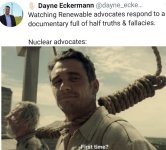lpetrich
Contributor
Renewable Energy: safe, clean, unlimited energy for our future on Reddit
India seeks to woo renewable energy firms shifting from China, plans manufacturing hubs at ports - india news - Hindustan Times - "The new and renewable energy ministry said on Saturday that at “a time when many companies are planning to shift their manufacturing base from China, it is [the] opportune time for India to bring policy changes for facilitating and catalysing manufacturing in India”."
That would be welcome - India is a much more open society than China.
Wind power is now America’s largest renewable energy provider | REVE News of the wind sector in Spain and in the world
Renewable Energy Accounts for Majority of New Capacity in 2019 - Solar Industry
India seeks to woo renewable energy firms shifting from China, plans manufacturing hubs at ports - india news - Hindustan Times - "The new and renewable energy ministry said on Saturday that at “a time when many companies are planning to shift their manufacturing base from China, it is [the] opportune time for India to bring policy changes for facilitating and catalysing manufacturing in India”."
That would be welcome - India is a much more open society than China.
Wind power is now America’s largest renewable energy provider | REVE News of the wind sector in Spain and in the world
Covid-19 to wreck economics of new solar, wind projects – pv magazine International - "While the impact of the Covid-19 pandemic on the renewable energy market is still not clear, Norwegian consultancy Rystad Energy says that new solar and wind projects will grind to a halt in 2020, creating a ripple effect in the years to come, as currencies throughout the world continue to slide against the US dollar"Wind power emerged from 2019 as America’s top choice for new power after building 9.1 gigawatts (GW), representing 39 percent of new utility-scale power additions. With these additions, operating wind power capacity in the U.S. now stands at over 105 GW, enough to power 32 million American homes. In addition, wind energy is now the largest provider of renewable energy in the country, supplying over 7 percent of the nation’s electricity in 2019. The newly released Wind Powers America Annual Report 2019 reveals that U.S. wind energy supports a record 120,000 American jobs, 530 domestic factories, and $1.6 billion a year in revenue for states and communities that host wind farms.
Renewable Energy Accounts for Majority of New Capacity in 2019 - Solar Industry
That's welcome, but we should be doing more.The renewable energy sector added 176 GW of generating capacity globally in 2019, slightly lower than the 179 GW added in 2018. However, new renewable power accounted for 72% of all power expansion last year, according to new data released by the International Renewable Energy Agency (IRENA).
IRENA’s annual Renewable Capacity Statistics 2020 shows that renewables expanded by 7.6% last year, with Asia dominating growth and accounting for 54% of total additions. While the expansion of renewables slowed last year, total renewable power growth outpaced fossil fuel growth by a factor of 2.6, continuing the dominance of renewables in power expansion first established in 2012. Solar and wind contributed 90% of total renewable capacity added in 2019.

